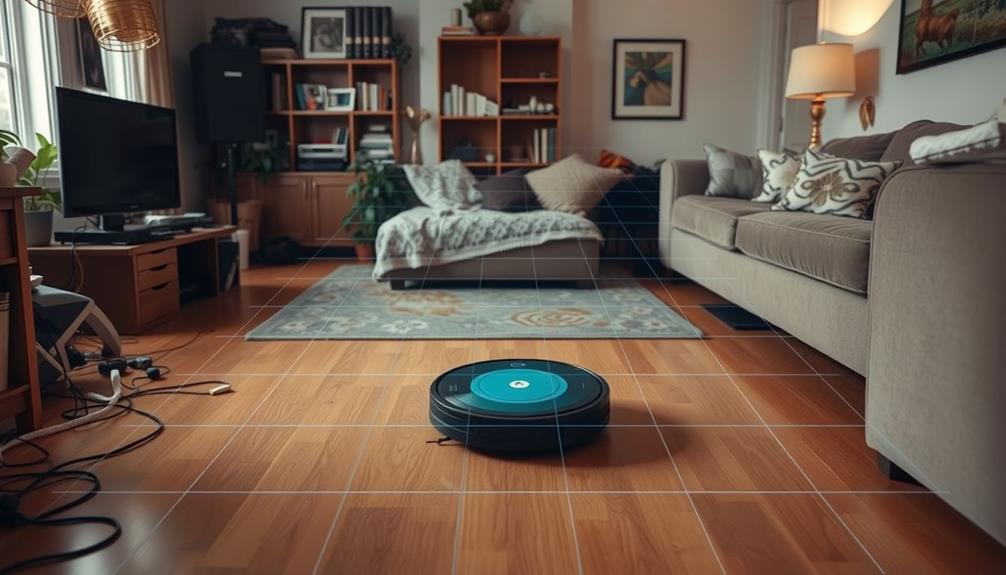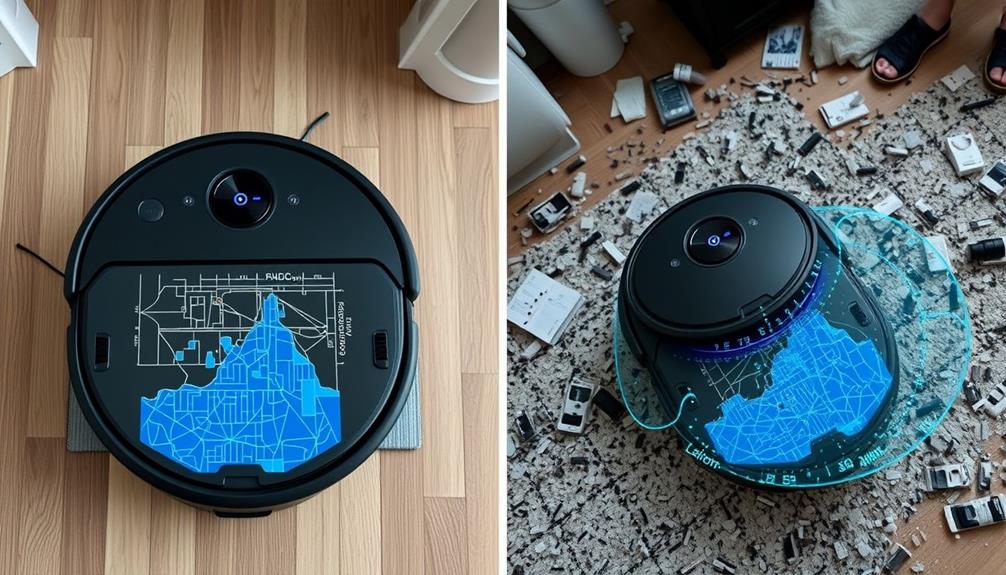When looking into robot vacuums, the performance greatly depends on the navigation systems in place. Mapping technologies are crucial as they create systematic cleaning paths, ensuring thorough coverage and reducing missed spots. These technologies are able to adapt to your home’s layout, allowing for efficient obstacle avoidance. On the other hand, random navigation often leads to inefficient cleaning, with vacuums taking over 100 minutes to complete a task and potentially missing areas altogether. This can result in repeated cleaning of the same spots and wasted battery life. Therefore, it’s important to understand these systems in order to choose the best vacuum for your needs. If you’re considering investing in a robot vacuum, make sure to prioritize the navigation system to achieve optimal cleaning performance. With a variety of options available, it’s worth researching to find the best robot vacuum deals that offer advanced mapping and navigation technology. By focusing on these features, you can ensure that your home receives the most effective and efficient cleaning possible.
Key Takeaways
- Mapping systems provide systematic cleaning paths, ensuring thorough coverage and minimizing missed spots compared to random navigation patterns.
- Advanced navigation technologies like SLAM and LiDAR enhance obstacle avoidance, reducing potential damage and interruptions during cleaning.
- Random navigation leads to inefficiencies, often resulting in longer cleaning times and repeated coverage of the same areas.
- Robot vacuums with mapping capabilities adapt to real-time changes in the environment, improving overall cleaning effectiveness.
- Advanced models significantly outperform budget options in speed and suction power, making them ideal for homes with pets.
Overview of Navigation Technologies
Robot vacuums have revolutionized home cleaning with their diverse navigation technologies. When you consider how these devices operate, you'll find various systems at play, each affecting cleaning efficiency and accuracy.
Basic sensor-based systems utilize an array of sensors to create random patterns, which often leads to longer cleaning times and incomplete floor coverage. Additionally, maintaining a clean environment can enhance the performance of these devices, similar to how air purifiers reduce allergens and improve indoor air quality.
On the other hand, camera mapping relies on built-in cameras for enhanced navigation and object recognition, though it can struggle in low-light conditions.
For more advanced performance, SLAM (Simultaneous Localization and Mapping) combines multiple sensors and data analysis to provide real-time mapping and precise navigation. This technology allows the vacuum to adapt dynamically to your home's layout.
LiDAR (Light Detection and Ranging) takes it a step further by using laser beams to measure distances, creating accurate maps that enable effective obstacle avoidance and faster cleaning paths. However, it can face challenges with transparent objects.
The choice of navigation technology is essential, as advanced systems like SLAM and LiDAR offer quicker and more thorough cleaning than the random patterns employed by lower-end models.
Advantages of Mapping Systems

With the integration of advanced mapping systems like SLAM and LiDAR, robot vacuums provide significant advantages over traditional models.
These technologies enhance cleaning efficiency and guarantee that your home receives a thorough clean without redundant work. For instance, many consumers find that best vacuums for pet hair benefit from systematic cleaning paths, as they can effectively tackle fur without missing spots.
Here are three key benefits of mapping systems:
- Systematic Cleaning Paths: Utilizing real-time maps, these vacuums navigate your home with precision, creating efficient cleaning routes that cover every inch without missing spots.
- Obstacle Avoidance: Advanced sensors in mapping vacuums enable superior obstacle avoidance, guaranteeing they glide around furniture and walls, reducing the risk of damage and interruptions during cleaning.
- Adaptability to Environmental Changes: Mapping capabilities allow robot vacuums to adjust their cleaning strategies based on changes in your home, whether it's moving furniture or varying floor types, guaranteeing peak performance.
Limitations of Random Navigation

Often, random navigation systems fall short when it comes to efficient cleaning. These budget models, like the Eufy RoboVac 11S, can take over 100 minutes to clean an area, leading to inefficient coverage and longer cleaning times. Without systematic mapping, they rely solely on basic sensors, resulting in incomplete cleaning patterns. You might find that areas are missed entirely, as these vacuums lack real-time mapping capabilities.
Additionally, similar to how one should avoid Gold IRA scams, it's vital to recognize the limitations of these vacuums and be cautious of their advertised capabilities.
In complex environments, random navigation systems struggle considerably. They can't adapt their cleaning paths based on obstacles or changes in your home layout, which often leads to collisions with furniture and walls. This not only wastes time but also increases wear and tear on the vacuum's components.
While advanced navigation systems can intelligently navigate around obstacles, random navigation vacuums may repeatedly clean the same spots, wasting battery life and extending the overall cleaning duration.
Ultimately, if you want effective and efficient cleaning, relying on random navigation can be a frustrating experience. You'll likely find yourself needing to run the vacuum more often, and it won't deliver the thoroughness that systematic mapping offers.
Performance Comparisons

When it comes to performance, advanced robot vacuums equipped with technologies like SLAM or LiDAR greatly outperform budget models.
These high-tech vacuums offer superior navigation and mapping capabilities, resulting in markedly improved cleaning efficiency. Additionally, models like the Bissell Pet Hair Eraser Vacuum provide enhanced suction power for effective hair removal, making them ideal for pet owners.
Here are three key performance comparisons:
- Cleaning Times: Advanced models can complete cleaning tasks in about 21 minutes, while budget models may take over 100 minutes to cover the same area.
- Suction Power: Advanced sensors enable models like the iRobot Roomba i7 Plus to achieve up to 8000Pa suction power, whereas budget options often struggle with lower suction and overall cleaning performance.
- Obstacle Navigation: Robot vacuums with mapping technology adapt their cleaning paths based on real-time environmental changes, effectively avoiding obstacles and reducing the need for multiple passes.
In contrast, random-pattern models miss spots, leading to longer cleaning times.
Future Trends in Robot Vacuums

The future of robot vacuums promises exciting advancements that will greatly enhance your cleaning experience. Advanced robot vacuums will increasingly incorporate AI algorithms, allowing them to adapt to real-time changes in your home environment.
With technologies like LiDAR and the SLAM system, these devices will create precise robot vacuum maps, enabling efficient navigation through complex spaces while avoiding obstacles. Additionally, as best gaming earbuds are designed for immersive experiences, similar innovations in robot vacuums will guarantee they operate quietly and unobtrusively, enhancing your overall home environment.
Expect seamless integration with smart home devices, letting you control your vacuum through voice commands or mobile apps. This enhanced connectivity will simplify your interactions and make cleaning more convenient than ever.
Battery technology will also see improvements, extending operational times and reducing the frequency of charging. This means your robot vacuum can tackle larger areas without interruption.
You'll also have more control over how your robot operates, thanks to customizable features such as virtual boundaries and targeted cleaning zones. These options will allow you to direct your vacuum to focus on high-traffic areas or avoid spaces that need no attention, ultimately improving cleaning performance.
As these advancements roll out, you'll find that robot vacuums become even more essential in maintaining your home's cleanliness.
Frequently Asked Questions
Is Robot Vacuum Mapping Worth It?
When you're considering whether robot vacuum mapping is worth it, think about the efficiency and convenience it brings.
With mapping technology, your vacuum can systematically clean your home, avoiding missed spots and reducing cleaning time. It remembers areas it's already cleaned, optimizing battery life and ensuring thorough coverage.
Plus, it navigates around obstacles, protecting your furniture. If you value effective cleaning and smart features, investing in mapping technology is definitely worth it.
What Does Mapping Mean in a Robot Vacuum?
Did you know that robot vacuums using mapping technology can clean up to 30% more efficiently than those without?
In a robot vacuum, mapping means creating a digital layout of your home using advanced technologies like SLAM or LiDAR. This allows the vacuum to navigate intelligently, adapt its cleaning routes, and remember areas it's already cleaned.
With mapping, your vacuum can tackle dirt more effectively and avoid obstacles, ensuring a thorough clean every time.
How Do Robot Vacuums Work Without Mapping?
Robot vacuums without mapping navigate using basic sensors that detect obstacles, cliffs, and walls.
You'll find they move in a random pattern, which means they often miss spots and may take longer to clean your floors—sometimes up to three times longer.
As you watch, you might notice them bouncing around, making multiple passes over the same area while struggling to cover complex environments efficiently, leading to less thorough cleaning overall.
Which Robot Vacuums Do Mapping?
When you think about robot vacuums with mapping capabilities, models like the DEEBOT X2 OMNI and DEEBOT T20 OMNI come to mind.
They use advanced technologies, like TrueMapping and AIVI, to create detailed maps of your home. This means they can navigate efficiently, avoiding obstacles while cleaning.
You can even control them through a mobile app, setting virtual boundaries or selecting specific areas for targeted cleaning, making your life a lot easier.
Conclusion
To summarize, choosing between mapping and random navigation systems in robot vacuums can greatly impact cleaning efficiency. Did you know that vacuums with mapping technology can cover up to 20% more floor space in a single pass compared to their random counterparts? This not only saves you time but also guarantees a more thorough clean. As technology evolves, expect even smarter navigation systems to emerge, making your cleaning routine easier and more efficient than ever.









